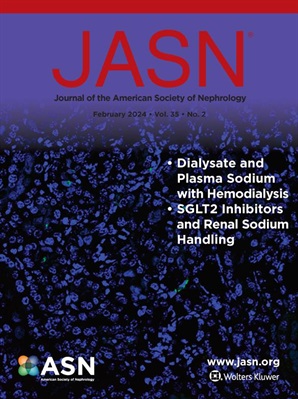Histologic Features Associated with Kidney Survival in Scleroderma Renal Crisis.
IF 9.4
1区 医学
Q1 UROLOGY & NEPHROLOGY
引用次数: 0
Abstract
BACKGROUND Scleroderma renal crisis is a severe complication of systemic sclerosis that is associated with higher morbidity and mortality. However, limited data are currently available regarding the factors affecting renal outcome during scleroderma renal crisis. The objective of this study is to describe renal histopathology in scleroderma renal crisis and to evaluate its association with kidney failure. METHODS We performed a French multicenter retrospective study that included 65 patients who underwent a kidney biopsy in the context of scleroderma renal crisis, between 2006 and 2020. Non-supervised hierarchical cluster analysis was used to identify histologic patterns. Cox model was performed to estimate the hazard ratios associated with histologic parameters for kidney failure, defined as the need for long-term dialysis therapy of or eGFR <15 ml/min/1.73m2 at last follow-up. Multiplexed sequential Immunofluorescence and proximity ligation assay was used in kidney biopsies to analyze complement system activation. RESULTS Renal pathology in scleroderma renal crisis was more heterogeneous than expected, with 3 histological patterns of kidney injury identified by cluster analysis. Multivariable analysis showed that together with creatinine at presentation, acute arteriolar thrombotic microangiopathy and onion skinning in small arteries were independently associated with the risk of kidney failure. Multiplex immunofluorescence identified fractions from the complement classical pathway in arterioles and arteries in scleroderma renal crisis, while proximity ligation experiments confirmed the in situ activation of classical pathway C3 convertase. Complement terminal pathway fraction C5b-9 was localized in injured arteries. CONCLUSIONS This study shows that the clinical definition of scleroderma renal crisis encompasses heterogeneity in the patterns of kidney injury. Acute arteriolar thrombotic microangiopathy and onion skinning were associated with kidney failure. Complement system was activated in these injured vessels.硬皮病肾危象患者肾脏存活的组织学特征。
背景:硬皮病肾危象是系统性硬化症的严重并发症,具有较高的发病率和死亡率。然而,目前关于硬皮病肾危象期间影响肾预后的因素的数据有限。本研究的目的是描述硬皮病肾危象的肾脏组织病理学,并评估其与肾衰竭的关系。方法:我们进行了一项法国多中心回顾性研究,纳入了2006年至2020年期间65例在硬皮病肾危象背景下接受肾活检的患者。采用非监督分层聚类分析来确定组织学模式。采用Cox模型估计与肾衰竭组织学参数相关的风险比,定义为在最后随访时需要长期透析治疗或eGFR <15 ml/min/1.73m2。多路序列免疫荧光和邻近结扎法用于肾脏活检分析补体系统激活。结果硬皮病肾危象患者的肾脏病理比预期的更为异质性,通过聚类分析确定了3种肾损伤的组织学模式。多变量分析显示,急性小动脉血栓性微血管病变和小动脉洋葱皮剥落与肾衰竭的风险独立相关。多重免疫荧光在硬皮病肾危重症的小动脉和动脉中鉴定了补体经典途径的部分,而近距离结扎实验证实了经典途径C3转化酶的原位激活。补体末端通路片段C5b-9定位于损伤动脉。结论:本研究表明,硬皮病肾危象的临床定义包含肾损伤模式的异质性。急性小动脉血栓性微血管病变和洋葱剥皮与肾衰竭有关。损伤血管的补体系统被激活。
本文章由计算机程序翻译,如有差异,请以英文原文为准。
求助全文
约1分钟内获得全文
求助全文
来源期刊
CiteScore
22.40
自引率
2.90%
发文量
492
审稿时长
3-8 weeks
期刊介绍:
The Journal of the American Society of Nephrology (JASN) stands as the preeminent kidney journal globally, offering an exceptional synthesis of cutting-edge basic research, clinical epidemiology, meta-analysis, and relevant editorial content. Representing a comprehensive resource, JASN encompasses clinical research, editorials distilling key findings, perspectives, and timely reviews.
Editorials are skillfully crafted to elucidate the essential insights of the parent article, while JASN actively encourages the submission of Letters to the Editor discussing recently published articles. The reviews featured in JASN are consistently erudite and comprehensive, providing thorough coverage of respective fields. Since its inception in July 1990, JASN has been a monthly publication.
JASN publishes original research reports and editorial content across a spectrum of basic and clinical science relevant to the broad discipline of nephrology. Topics covered include renal cell biology, developmental biology of the kidney, genetics of kidney disease, cell and transport physiology, hemodynamics and vascular regulation, mechanisms of blood pressure regulation, renal immunology, kidney pathology, pathophysiology of kidney diseases, nephrolithiasis, clinical nephrology (including dialysis and transplantation), and hypertension. Furthermore, articles addressing healthcare policy and care delivery issues relevant to nephrology are warmly welcomed.

 求助内容:
求助内容: 应助结果提醒方式:
应助结果提醒方式:


